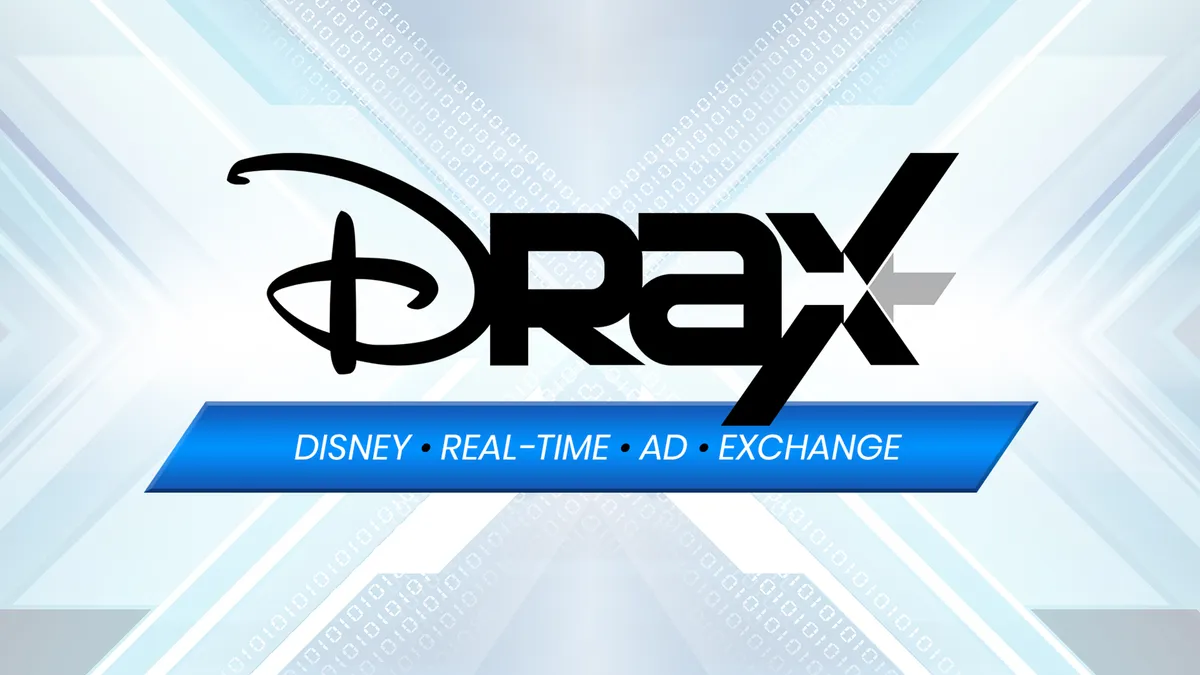Dive Brief:
- Disney introduced a data-driven plan to unify its advertising sales among digital and linear TV screens that includes the rollout of a programmatic business called Disney Real-Time Ad Exchange (DRAX). The plan was unveiled at an invitation-only event for clients on Feb. 23 called the Disney Platform Tech Showcase.The media and entertainment giant expects automated ad revenue to grow more than 80% this year, with programmatic sales making up as much as half of addressable revenue by 2024, per an announcement.
- More than 1,000 net new clients have bought ad inventory across the Disney Platform, which includes the streaming platform Hulu, through programmatic channels in the past year. That growth accelerated with the January launch of Disney Hulu XP (DHXP), which enables advertisers to place ads across Hulu and Disney's TV networks and whose adoption quadrupled in its first 30 days, according to Disney.
- Disney pulled together its first-party consumer data and audience modeling into a platform called Disney Select that lets marketers pick target segments based on buyer behavior, household characteristics and psychographics. Platforms like Disney Select that rely on first-party data are poised to become even more essential as the data privacy landscape tightens.
Dive Insight:
Disney's first technology showcase aimed to prepare advertisers and their media agencies for the upfront sales season that starts in May, though like last year, the pandemic will prevent TV networks from hosting in-person events. With viewers spending more time watching video on connected devices like smart TVs and mobile phones, Disney is emphasizing a cross-platform approach to selling its ad inventory on traditional linear TV and increasingly crucial streaming platforms like Hulu. Disney’s online ad sales on platforms including Hulu, ESPN+ and ABC.com rose 47% to $882 million last quarter, and could soon surpass ad sales on the ABC broadcast network, which saw a 5% gain to $984 million, per an online investor conference cited by Ad Age.
Disney's efforts include the launch of its Disney Real-Time Ad Exchange (DRAX) for programmatic buys and Disney Select for data-driven targeting. The company has seen a 56% increase from a year earlier in the number of campaigns that use data of any kind to target audiences, while revenue has jumped 110%, per the announcement.
"This new way of doing business will be optimizable in real-time through our programmatic offerings," Lisa Valentino, executive vice president of client solutions and addressable enablement at Disney Advertising Sales, said in the announcement. "The buys will be data-enabled with precision targeting and built on Disney’s audience graph that can be complemented with marketer’s own data."
The launch of DRAX, which shares its name with a character from Disney's "Guardians of the Galaxy" films, is part of Disney's plan to fully automate ad sales through programmatic platforms as more TV advertising becomes addressable, letting marketers reach different households with different ads based on consumer data.
Disney's latest announcements follow the January launch of Disney Hulu XP, which lets marketers unify their ad buys on its TV networks and streaming service Hulu. Since taking control of Hulu in 2019, Disney has expanded the platform with new ad formats such as its Gateway Go product for direct-response advertisers during last year's NewFronts presentation. Hulu won't appear at this year's NewFronts for digital advertising as Disney combines the streaming platform with its upfront presentation in May, Adweek reported. The move reflects the company's approach to media convergence.
"As Disney embarks on a single unified ad platform across linear and digital that addresses this reality and market opportunity, we expect convergence to continue in three distinct areas: planning and forecasting, reporting and measurement and cross-channel optimization," said Jeremy Helfand, senior vice president and head of advertising platforms at Disney Media and Entertainment Distribution (DMED). "We want advertisers to be able to buy once, deliver everywhere and have common measurement for real-time optimizing campaign results with Disney."
Disney's approach to upfronts comes as advertisers and media buyers increasingly question the traditional practice of committing to buy big swaths of premium ad inventory in anticipation of fall premieres for shows. Procter & Gamble, one of the world's biggest advertisers by media spend, made a splash in shirking the traditional TV upfronts last year. Instead, the consumer packaged goods company decided to negotiate directly with the networks, looking to avoid "legacy systems that have historically favored sellers," Marc Pritchard, P&G's chief brand officer, said in a speech the virtual Consumer Electronics Show in January.
Still, most advertisers plan to keep their media allocations consistent this year, spending 40% for upfront and 60% for scatter, a survey by researcher Advertiser Perceptions recently found. While viewership of traditional linear TV has declined as people embrace streaming, 51% of advertisers said linear TV is their top priority, compared with 16% for social media and 15% for video sites, the survey found.
Spending on U.S. programmatic CTV video ads willl increase by more than 54% to $6.73 billion this year and by 29% to $8.67 billion in 2022, researcher eMarketer estimated in October. Sixty percent of U.S. advertisers said they planned to shift ad dollars from linear TV to either CTV or over-the-top (OTT) streaming services this year, according to a November survey by the Interactive Advertising Bureau (IAB).












